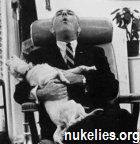This is not a very scientific posting! It's suggested by Roger Desjardins's comment that the Amarillo, Texas, 'nuclear bomb' assembly plant, has X-ray machines used to irradiate metals so that they appear to be radioactive, and can simulate nuclear weapons to people with test equipment.
A serious problem with assessing published material is that the authors don't distinguish theory from what's found in practice - so if the theory, mathematical or theoretical, is misleading or wrong, it's difficult to guess whether the effects reported are in fact shown in practice. (I hope that's clear!) X-rays are supposed to be a short-wavelength form of light, generated either by electrons shifting in their orbits, or by parts of the nucleus changing. There's little doubt (cf. Fraunhofer lines) that there are very repeatable and very precise emissions of light and X-rays; whether these are waves, or particles, remains uncertain. But if atoms can be made to generate light, infra red etc, and X-rays, why shouldn't X-rays have the reverse effect on atoms; for example, converting carbon-12 to carbon-14, or isotopes of lead to other radioactive isotopes?
There's a problem here, which is that any scientific topic which might reveal nuclear reactions as problematic will be censored. Nobody will publish a paper describing how to mimic atom bombs! Or at least not yet!
Another issue is technical progress. Thus NMR (nuclear magnetic resonance), or as it was renamed MRI (magnetic resonance imaging), has both a strong, shaped magnetic field generated electrically, plus a radio field, also generated electrically, working simultaneously to cause an image to be output. Surely a powerful X-ray, of an appropriate wavelength, maybe with a powerful magnetic field, ought to be able to create radioactivity where it didn't exist before?
• Can X-Ray Irradiation Make Radioactive Isotopes?
2 posts
• Page 1 of 1
-

rerevisionist - Site Admin
- Posts: 1056
- Joined: 18 Mar 2011 11:40
Re: Can X-Ray Irradiation Make Radioactive Isotopes?
Microwave ovens don't get radioactive.
Common color televisions generate X-rays. That's why color picture tubes have a half inch or so of leaded glass on the front.
Common color televisions generate X-rays. That's why color picture tubes have a half inch or so of leaded glass on the front.
-

FirstClassSkeptic - Posts: 671
- Joined: 20 Mar 2011 21:19
2 posts
• Page 1 of 1
Return to Science, Nuclear Physics, Astronomy, Space Travel
Who is online
Users browsing this forum: No registered users and 1 guest